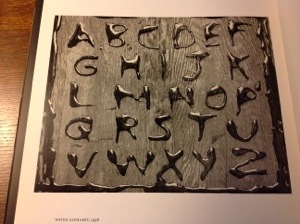
© Myriapod Productions, 2013
“Previously on …” Say the phrase and most listeners’ brains switch to a favorite channel and television series. It is part of our vernacular. It instantly evokes a compound state of remembering and anticipating.
Myriapod Productions embodies that state of mind in its animated alphabet-book film series Mysteries of Vernacular. Each book for each letter is an old yellowed or gray hardback whose pages turn by themselves to reveal silhouette figures that glide across the pages, accordioned illustrations from other works or carvings reminiscent of the book sculptures of Doug Beube, Brian Dettmer and Odires Mlászho – with each vernacular word and definition emerging from an old library card pocket or from beneath a flap or cutout on the page.
The treatment of the letter W is particularly apropos to this compound artwork. W is for “window”, which we are informed by Graham James (the narrator) is an example of the Old Norse technique of word invention called kenning. Kenning is the joining of two things (or rather two words for two different things) to designate a third thing: such as whale + road = whale-road = sea. Window is originally an Old Norse kenning word: windauga = vind (wind) + auga (eye). The book in the animation is Mikhail Sholokhov‘s The Don Flows Home to the Sea, a Nobel-prize-winning window on the life of the Don Cossacks during the Russian Revolution.
The book for the letter A (for “assassin”) is Karl Menninger‘s Love against Hate, whose theme of love’s shaping our instinctual aggressiveness suggests an ironic bent and wry, punning sense of humor in Jessica Oreck and her Myriapod team. The letter C for “clue” traces back to the ball of yarn (clew) that Ariadne gave Theseus to help him find his way out of the maze after killing the Minotaur, which is explained with an animation of George Bernard Shaw‘s The Intelligent Woman’s Guide to Socialism and Capitalism. C is also for “clever”.
D for “dynamite” plays out on the pages of A Number of Things, a satiric novel of Irish and British manners by Honor (Lilbush Wingfield) Tracy. Tracy became the fuse to a stick of dynamite planted by Bevis Hillier in his rival A.N. Wilson‘s biography of Sir John Betjeman. Hillier concocted a letter from Betjeman purporting to reveal an affair between Tracy and the Oxford don. Not only was the letter a hoax, but Hillier embedded an acrostic that spelled out “A N Wilson is a shit”.
Of course, X for “x-ray” is illuminated with George Iles‘ Little Masterpieces of Science, and naturally, Z for “zero” is accounted for with Teach Yourself Calculus. But this soupçon of humor runs out with H (what has “hearse” to do with Bernard Jaffe‘s story of chemistry?) and G (what has “gorgeous” to do with James Russell Lowell?) and F (what has “fizzle” to do with Mark Twain‘s Life on the Mississippi, although one can imagine his delight with the word’s etymological kinship with flatulence?).

© Myriapod Productions, 2013
Each letter, definition, chapter, volume, episode (?) of Mysteries of Vernacular elicits affection for, if not outright love of, words and language. Perhaps that is not just down to Oreck’s and team’s skill, humor and cleverness. After all, for most of us, the alphabet-book is our childhood entrée not only to letters and words but any aspect of the internal and external world we fancy. Just for ages 3-5, our bookstores and libraries have the ABCs of Asthma, Bible Verse, Colors, Dinosaurs, Engineering, Feelings, Golf, Halloween, Ice Cream, Jobs, Kangaroos, Love, Math Riddles, Nature, Origami, Pigs, Questions, Rocks, Sounds, Touch, Under the Sea, Vanishing (endangered species), Wildlife, Yoga and Zoos. And for the more app-minded, there is also Moonbot Studio‘s contribution to the ABCs: The Numberlys.

William Joyce, Moonbot Studios, 2012
Myriapod starts with the advantage of this long, long “previously on …” in our hearts and minds. In exploiting its advantage, Mysteries of Vernacular takes us on a gentle rootle round the attic and cellar of our language and social history. The tradition of the abecedary and the disciplines of history and etymology offer a natural canvas on which Myriapod’s animation projects numerous techniques of book art. The intaglio carving reminds us not only of Beube, Dettmer and Mlászho but more so of Nerhol (the collaboration persona of Ryuta Iida and Yoshihisa Tanaka) and the work entitled Oratorical Type.


The Mysteries’ wooden desktop framing recalls Abelardo Morell‘s A Book of Books.

Abelardo Morell
The animated book folds are enchanting (although they might have but do not aspire to the level of origami achieved by artists and craftworkers like Heather Eddy).

Heather Eddy, 2013

Heather Eddy, 2013
More extensively used and in keeping with the more two-dimensional feel of Mysteries is the technique of papercutting (as distinct from carving) on display with the letter W. The technique dates to the Tang Dynasty (618 -906 AD) but, in this context, harks back more recently to Victorian silhouette artistry.

The series of 26 episodes so rich in content and technique is addictive. You will find yourself, as with any well-done abecedary, wishing for more letters in the alphabet. Although there is a vast vocabulary of other vernacular awaiting treatment, at a production cost of $80,000 per episode, it is likely those words will wait a long time. So we are left with having to remember our anticipation. Not all anticipation is more often enjoyed in itself rather than its resolution. You have 26 windows of opportunity to learn in Mysteries of Vernacular.
Look here, here and here for more abcedaries. And here for the online exhibition at the University of Delaware.